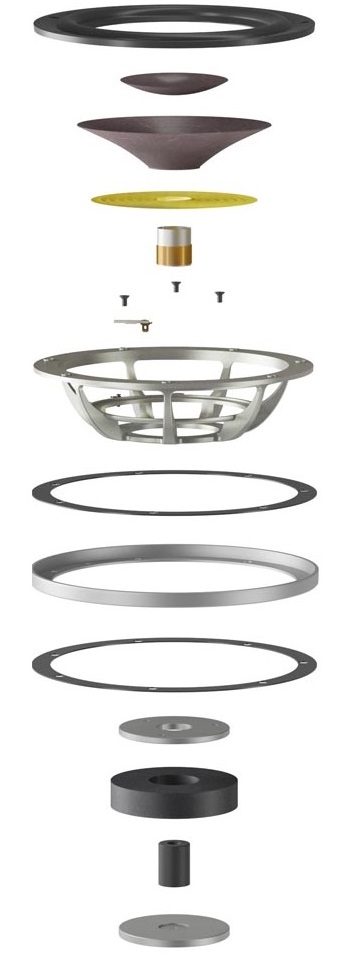Speaker Structure
 A speaker is an electronic device that generates audio signals. The sound quality depends on the characteristics of the speaker. Although it is the weakest component of audio equipment, it is the most important for sound effects.
A speaker is an electronic device that generates audio signals. The sound quality depends on the characteristics of the speaker. Although it is the weakest component of audio equipment, it is the most important for sound effects.
There are several types of speakers and different price ranges for them. To create sound, you need to make the diffuser or diaphragm resonate with the air. For this purpose, electromagnetic, piezoelectric, or electrostatic effects are used.
Types of speakers
Wooden speakers reduce the sound spot that arises due to the body resonance. In general, these speakers are better than plastic ones.
Plastic speakers are considered inferior because their thin enclosures don’t provide high sound quality and overcome resonance (but some well-designed plastic models are much better than low-quality wooden ones).
Multimedia speakers most often have a dual-frequency system: a smaller speaker that outputs the mid to high range and a larger one that outputs mid-bass.
Choosing speakers, you should consider the materials they are made from: high-quality multimedia speakers have soft domes (as an addition to the titanium used for the analog sound sources). They reduce the high frequencies in digital sound sources. A cold signal will give you a feeling of indifference, weakness, and lightness. The multimedia speaker system has soft dome tops, silk films of excellent quality, and less expensive photovoltaic films.
What does the speaker consist of?
A typical loudspeaker consists of a voice coil, a magnet, a frame, a centering support piece, and a paper cone with a molded ring cone.
Voice Coil
A voice coil is a primary element of the paper cone speaker. It is wound on a paper tube in two layers with very thin copper wire. Typically, tens of coils are placed on the magnetic core and in the magnetic gap formed by the magnetically conductive plate. The voice coil and paper cone are fixed together. When the sound signal passes through the voice coil, the vibration of the voice coil causes the paper cone to vibrate.
Paper cone
The diaphragm of the cone speaker can be made from a variety of materials. There are usually two types of fiber: natural and synthetic. Natural fibers often use cotton, wool, silk, etc., and synthetic fibers include viscose, nylon, and fiberglass. Since the paper cone is the sound emitting component, it largely determines the sound reproduction quality. No matter what the paper cone is, it should be light and rigid and not deform due to temperature and humidity changes in the environment.
Folding ring
The folding ring moves the paper cone in the axial direction of the speaker and limits lateral movement. At the same time, it blocks airflow between the front and rear of the speaker. In addition to the materials used for the paper cone, a folding ring uses plastic, natural rubber, and other materials hot-pressed to the paper cone.
Centering support
The centering support is designed to support the voice coil connector and the paper cone to maintain its vertical position and prevent distortion. Many concentric rings are disposed on the centering support plate, so the voice coil can freely move up and down in the magnetic gap without lateral movement. It ensures that the voice coil does not collide with the magnetically conductive plate. There is also a dust cover on the centering support. It protects the magnetic gap from dust and prevents friction between the dust and the voice coil, which can cause the poor sound of the speaker.
Diffuser as an essential component
The bass unit also directly affects the sound of the speaker. Therefore, when choosing, you should pay attention to the diffuser as well. The most common types are paper cones, paper-based textile fiber cones, and tightly packed polypropylene fabric cones.
The paper cone is characterized by natural sound, low cost, good hardness, lighter material, and high sensitivity. And disadvantages are poor moisture resistance and a difficult manufacturing process. Nevertheless, there are plenty of excellent HiFi systems made of paper cones since we get an excellent sound at the output. And a bonus is good convergence.
The polypropylene fabric cone has a wider frequency range and less distortion. It is an excellent choice for those who love strong bass. The disadvantages are high cost, complex manufacturing process, low sensitivity, and weak light and music effect.
Cones made of textile fibers on a paper base have a soft texture. They have poor bass effects and lack the strength and punch, so they are better for light music.
Polypropylene cones, common in high-quality loudspeakers, have excellent density and low distortion, and their performance is good in all aspects. In addition, there are fiber and composite cones, but they are rarely used in well-known speaker systems due to their high cost.
Of course, the larger the size of the speaker, the better: a big caliber woofer has a better performance in the low-frequency section that you can choose when purchasing. High-performance speakers significantly reduce transient distortions and deliver excellent sound quality. The woofers of conventional multimedia speakers are on average 3 to 5 inches in size.
Paper cone loudspeakers used to be called electric cone loudspeakers. Although in 2014, paper diffusers still predominated in the diaphragm, at the same time, metal diaphragms and diaphragms made of different polymeric materials appeared. The name “cone loudspeaker” is a shorthand name.
We offer a wide range of speakers and popular audio systems with electric diffusers. Contact us for advice to find the best option!

